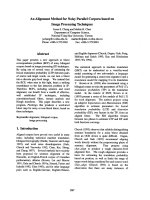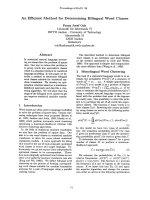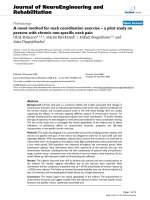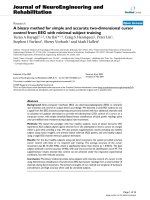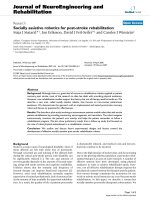Báo cáo hóa học: "AN APPROXIMATION METHOD FOR CONTINUOUS PSEUDOCONTRACTIVE MAPPINGS" potx
Bạn đang xem bản rút gọn của tài liệu. Xem và tải ngay bản đầy đủ của tài liệu tại đây (502.72 KB, 9 trang )
AN APPROXIMATION METHOD FOR CONTINUOUS
PSEUDOCONTRACTIVE MAPPINGS
YISHENG SONG AND RUDONG CHEN
Received 20 March 2006; Rev ised 24 May 2006; Accepted 28 May 2006
Let K beaclosedconvexsubsetofarealBanachspaceE, T : K
→ K is continuous pseudo-
contractive mapping, and f : K
→ K is a fixed L-Lipschitzian strongly pseudocontractive
mapping. For any t
∈ (0,1), let x
t
be the unique fixed point of tf +(1− t)T.Weprovethat
if T has a fixed point and E has uniformly G
ˆ
ateaux differentiable norm, such that every
nonempty closed bounded convex subset of K has the fixed point property for nonex-
pansive self-mappings, then
{x
t
} convergestoafixedpointofT as t approaches to 0.
The results presented extend and improve the corresponding results of Morales and Jung
(2000) and Hong-Kun Xu (2004).
Copyright © 2006 Y. Song and R. Chen. This is an open access article distributed under
the Creative Commons Attribution License, which permits unrestricted use, distribution,
and reproduction in any medium, provided the original work is properly cited.
1. Introduction and preliminaries
Let E bearealBanachspaceandletJ denote the normalized duality mapping from E
into 2
E
∗
given by J(x) ={f ∈ E
∗
,x, f =x f ,x=f },forallx ∈ E,whereE
∗
denotes the dual space of E and ·,· denotes the generalized duality pairing. If E
∗
is
strictly convex, t hen J is single-valued. In the sequel, we will denote the sing le-valued
duality mapping by j, and denote F(T)
={x ∈ E; Tx = x}.InBanachspaceE,thefol-
lowing result (the subdifferential inequality) is well known [1, 5]. For all x, y
∈ E,forall
j(x + y)
∈ J(x + y), and for all j(x) ∈ J(x),
x
2
+2
y, j(x)
≤
x + y
2
≤x
2
+2
y, j(x + y)
. (1.1)
Recall that the norm of E is said to be G
ˆ
ateaux differentiable (and E is said to be smooth),
if the limit
lim
t→0
x + ty−x
t
(*)
Hindawi Publishing Corporation
Journal of Inequalities and Applications
Volume 2006, Article ID 28950, Pages 1–9
DOI 10.1155/JIA/2006/28950
2 Continuous pseudocontractive mappings
exists for each x, y on the unit sphere S(E)ofE.Moreover,ifforeachy in S(E)the
limit defined by (*) is uniformly attained for x in S(E), we say that the norm of E is
uniformly G
ˆ
ateaux differentiable.ThenormofE is said to be Fr
´
echet differentiable,iffor
each x
∈ S(E) the limit (*)isattaineduniformlyfory ∈ S(E). The norm of E is said to
be uniformly Fr
´
echet differentiable (and E is said to be uniformly smooth), the limit (*)is
attained uniformly for (x, y)
∈ S(E) × S(E).
The following results which are found in [1, 4, 5]arewellknown.
(i) The duality mapping J in smooth Banach space E is single-valued and strong-
weak
∗
continuous [5, Lemma 4.3.3].
(ii) If E isaBanachspacewithauniformlyG
ˆ
ateaux differentiable norm, then the
mapping J : E
→ E
∗
is single-valued and norm-to-weak star uniformly continu-
ous on bounded sets of E [5, Theorem 4.3.6].
(iii) In uniformly smooth Banach space E, the mapping J : E
→ E
∗
is single-valued
and norm-to-norm uniformly continuous on bounded sets of E [5,Theorem
4.3.6].
(iv) A uniformly convex Banach space E is reflexive and strictly convex [5,Theorems
4.1.6 and 4.1.2].
(v) If K is a nonempty convex subset of a strictly convex Banach space E and T : K
→
K is a nonexpansive mapping, then fixed point set F(T)ofT is a closed convex
subset of K [5, Theorem 4.5.3].
Let E be a real Banach space and let T be a mapping with domain D(T) and range
R(T)inE. T is called pseudocontractive (resp., strongly)ifforanyx, y
∈ D(T), there exists
j(x
− y) ∈ J(x − y)suchthat
Tx− Ty, j(x − y)
≤
x − y
2
resp.,
Tx− Ty, j(x − y)
≤
βx − y
2
for some 0 <β<1
.
(1.2)
If I denotes the identity operator, then (1.2) implies that
(I − T)x − (I − T)y, j(x − y)
≥
0, (1.3)
(I − T)x − (I − T)y, j(x − y)
≥
(1 − β)x − y
2
. (1.4)
Let K be a closed convex subset of a uniformly smooth Banach space E, T : K
→ K a
nonexpansive mapping with F(T)
=∅, f : K → K a contraction. Then for any t ∈ (0,1),
the mapping
T
f
t
: x −→ tf(x)+(1− t)Tx (1.5)
is also contraction. Let x
t
denote the unique fixed point of T
f
t
.In[7], Xu proved that as
t
↓ 0, {x
t
} converges to a fixed point p of T that is the unique solution of the variational
inequality
(I − f )u, j(u − p)
≤
0 ∀p ∈ F(T). (1.6)
Y. Song and R. Chen 3
Let K be a nonempt y closed convex subset of a Banach space E, T : K
→ K acontinuous
pseudocontractive map such that F(T)
=∅,and f : K → K a fixed Lipschitzian strongly
pseudocontractive map. Then for any t
∈ (0,1), T
f
t
= tf +(1− t)T : K → K is also a con-
tinuous strongly pseudocontractive map. Let x
t
be the unique fixed point of T
f
t
(see [1]),
that is,
x
t
= tf
x
t
+(1− t)Tx
t
. (1.7)
In this paper, our purpose is to prove that
{x
t
} defined by (1.7) strongly converges to
a fixed point of T, which generalizes and i mproves several recent results. Particularly, it
extends and improves [7, Theorems 3.1 and 4.1]. Let μ be a continuous linear functional
on l
∞
satisfying μ=1 = μ(1). Then we know that μ is a mean on N if and only if
inf
a
n
; n ∈ N
≤ μ(a) ≤ sup
a
n
;n ∈ N
(1.8)
for every a
= (a
1
,a
2
, ) ∈ l
∞
. According to time and circumstances, we use μ
n
(a
n
)instead
of μ(a). A mean μ on
N is called a Banach limit if
μ
n
a
n
=
μ
n
a
n+1
(1.9)
for every a
= (a
1
,a
2
, ) ∈ l
∞
. Furthermore, we know the following result [6, Lemma 1]
and [5, Lemma 4.5.4].
Lemma 1.1 (see [6, Lemma 1]). Let C be a nonempty closed convex subset of a Banach space
E with a uniformly G
ˆ
ateaux differentiable norm. Let
{x
n
} be a bounded sequence of E and
let μ be a mean on
N.letz ∈ C. Then
μ
n
x
n
− z
2
= min
y∈C
μ
n
x
n
− y
2
(1.10)
if and only if
μ
n
y − z, j
x
n
− z
≤
0 ∀y ∈ C, (1.11)
where j is the duality mapping of E.
2. Main results
Lemma 2.1. Let E be a Banach space and let K be a nonempty closed convex subset of E.
Suppose that T : K
→ K is a pseudocontractive mapping such that for each fixed strongly
pseudocontractive map f : K
→ K,theequation
x
= tf(x)+(1− t)Tx (2.1)
has a solution x
t
for each t ∈ (0,1).Supposethatu ∈ K is a fixed point of T. Then
(i)
{x
t
} is bounded;
(ii)
x
t
− f (x
t
), j(x
t
− u)≤0.
4 Continuous pseudocontractive mappings
Proof. (i) As u is a fixed point of T,wehave
x
t
− u
2
=
t
f
x
t
−
u
+(1− t)
Tx
t
− u
, j
x
t
− u
=
t
f
x
t
−
u, j
x
t
− u
+(1− t)
Tx
t
− u, j
x
t
− u
=
t
f
x
t
−
f (u), j
x
t
− u
+ t
f (u) − u, j
x
t
− u
+(1− t)
Tx
t
− Tu, j
x
t
− u
≤
t
f
x
t
−
f (u), j
x
t
− u
+ t
f (u) − u, j
x
t
− u
+(1− t)
x
t
− u
2
≤ βt
x
t
− u
2
+ t
f (u) − u, j
x
t
− u
+(1− t)
x
t
− u
2
.
(2.2)
Hence
(1
− β)
x
t
− u
2
≤
f (u) − u, j
x
t
− u
≤
f (u) − u
·
x
t
− u
. (2.3)
By (2.3), we get
x
t
− u
≤
1
1 − β
f (u) − u
, (2.4)
so that
{x
t
:0<t<1} is bounded.
(ii) As u is a fixed point of T,fromx
t
= tf(x
t
)+(1− t)Tx
t
,weget
x
t
− f
x
t
, j
x
t
− u
=
(1 − t)
Tx
t
− f
x
t
, j
x
t
− u
=−
(1 − t)
(I − T)x
t
− (I − T)u, j
x
t
− u
+(1− t)
x
t
− f
x
t
, j
x
t
− u
(using (1.3))
≤ (1− t)
x
t
− f
x
t
, j
x
t
− u
.
(2.5)
Therefore
x
t
− f (x
t
), j(x
t
− u)≤0. The proof is complete.
Theorem 2.2. Let E beareflexiveBanachspacewithauniformlyG
ˆ
ateaux differentiable
norm. Suppose K is a nonempty closed convex subset of E and T : K
→ K is a continuous
pseudocontractive mapping. Let f : K
→ K be a fixed Lipschitzian strongly pseudocontracitve
map from K to K. Every nonempty closed bounded convex s ubset of K has the fixed point
property for nonexpansive self-mappings.
{x
t
} (for all t ∈ (0,1)) is defined by (1.7). Then
{x
t
:0<t<1} is bounded if and only if, as t → 0, x
t
converges strongly to a fixed point p of
T such that p is the unique solution in F(T) to the following variational inequality:
(I − f )p, j(p − u)
≤
0 ∀u ∈ F(T). (2.6)
Y. Song and R. Chen 5
Proof. At first, by Lemma 2.1(i), the sufficiency is obvious.
Secondly, we show the necessity. Since
{x
t
:0<t<1} is bounded, f are Lipschitzian
mappings, the sets
{ f (x
t
):t ∈ (0,1)} are bounded. By x
t
= tf(x
t
)+(1− t)Tx
t
,wehave
Tx
t
=
1
1 − t
x
t
−
t
1 − t
f
x
t
,
Tx
t
≤
1
1 − t
x
t
+
t
1 − t
f
x
t
.
(2.7)
Therefore, the sets
{Tx
t
} are also bounded (using t → 0). This implies that
lim
t→0
x
t
− Tx
t
=
lim
t→0
t
Tx
t
− f
x
t
=
0. (2.8)
We first observe that the mapping 2I
− T has a nonexpansive inverse, denoted by A =
(2I − T)
−1
,whereI denotes the identity operator, then F(T) = F(A) (see [1, 5]). By [3,
Theorem 6], we get that A is a nonexpansive self-mapping on K. Using A
= (2I − T)
−1
,
we obtain
x
t
− Tx
t
= (2I − T)x
t
− x
t
= A
−1
x
t
− x
t
, x
t
= AA
−1
x
t
,
x
t
− Ax
t
=
AA
−1
x
t
− Ax
t
≤
A
−1
x
t
− x
t
=
x
t
− Tx
t
.
(2.9)
Since lim
t→0
x
t
− Tx
t
=0, we have
lim
t→0
x
t
− Ax
t
=
0. (2.10)
We claim that the set
{x
t
: t ∈ (0,1)} is relatively compact. In fact, let {t
n
} be a sequence
in (0,1) that converges to 0 (n
→∞), put x
n
:= x
t
n
,
g(x)
= μ
n
x
n
− x
2
∀x ∈ K, (2.11)
where μ is a Banach limit. Define the set
K
1
=
x ∈ K : g(x) = inf
y∈K
g(y)
. (2.12)
Since E isareflexiveBanachspace,K
1
is a nonempty bounded closed convex subset of E
(for more details, see [5]), and since
lim
n→∞
x
n
− Ax
n
=
0, (2.13)
for all x
∈ K
1
,weget
g(Ax)
= μ
n
x
n
− Ax
2
= μ
n
Ax
n
− Ax
2
≤ μ
n
x
n
− x
2
= g(x).
(2.14)
Hence, Ax
∈ K
1
, that is, K
1
is invariant under A. Since every nonempty closed bounded
convex subset of K has the fixed point property for nonexpansive self-mappings, there is
6 Continuous pseudocontractive mappings
afixedpointp
∈ K
1
of A.ByF(T) = F(A), p is also a fixed point of T. Using Lemma 1.1,
we get
μ
n
x − p, j
x
n
− p
≤
0 ∀x ∈ K. (2.15)
By (2.3), and taking x
= f (p), we have
μ
n
x
n
− p
2
≤
1
1 − β
μ
n
f (p) − p, j
x
n
− p
≤
0, (2.16)
that is,
μ
n
x
n
− p
2
= 0. (2.17)
We have proved that for any sequence
{x
t
n
} in {x
t
: t ∈ (0,1)}, there exists a subsequence
whichisstilldenotedby
{x
t
n
} that converges to some fixed point p of T. To prove that the
entire net
{x
t
} converges to p, supposed that there exists another sequence {x
s
k
}⊂{x
t
}
such that x
s
k
→ q,ass
k
→ 0, then we also have q ∈ F(T) (using lim
t→0
x
t
− Tx
t
=0).
Next we show that p
= q and p is the unique solution in F(T) to the following variational
inequality:
(I − f )p, j(p − u)
≤
0 ∀u ∈ F(T). (2.18)
Since the sets
{x
t
− u} and {x
t
− f (x
t
)} are bounded and the duality map J is single-
valued and nor m to weak
∗
uniformly continuous on bounded sets of a Banach space E
with uniformly G
ˆ
ateaux differentiable norm, for any u
∈ F(T), by x
s
k
→ q(s
k
→ 0), we
have
(I − f )x
s
k
− (I − f )q
−→
0
s
k
−→ 0
,
x
s
k
− f
x
s
k
, j
x
s
k
− u
−
(I − f )q, j(q − u)
=
(I − f )x
s
k
− (I − f )q, j
x
s
k
− u
+
(I − f )q, j
x
s
k
− u
−
j(q − u)
≤
(I − f )x
s
k
− (I − f )q
x
s
k
− u
+
(I − f )q, j
x
s
k
− u
−
j(q − u)
−→
0ass
k
−→ 0.
(2.19)
Therefore, noting Lemma 2.1(ii), for any u
∈ F(T), we get
(I − f )q, j(q − u)
=
lim
s
k
→0
x
s
k
− f
x
s
k
, j
x
s
k
− u
≤
0. (2.20)
Similarly, we also can show that
(I − f )p, j(p − u)
=
lim
n→∞
x
t
n
− f
x
t
n
, j
x
t
n
− u
≤
0. (2.21)
Y. Song and R. Chen 7
Interchange p and u to obtain
(I − f )q, j(q − p)
≤
0. (2.22)
Interchange q and u to obtain
(I − f )p, j(p − q)
≤
0. (2.23)
This implies that (using (1.4))
(1
− β)p − q
2
≤
(I − f )p − (I − f )q, j(p − q)
≤
0. (2.24)
We must have p
= q. The proof is complete.
Since every bounded nonempty closed convex subset with normal structure of the
reflexive Banach space has the fixed point property for nonexpansive self-mappings [1, 5],
and if F(T)
=∅,byLemma 2.1(i), we have {x
t
:0<t<1} is bounded, so that we can
obtain the following corollary.
Corollary 2.3. Let E beareflexiveBanachspacewithauniformlyG
ˆ
ateaux differentiable
norm. Suppose K is a nonempty closed convex subse t of E with normal structure and T : K
→
K is a cont inuous pseudocontractive mapping such that F(T) =∅.Let f : K → K beafixed
Lipschitzian strongly pseudocontracitve map from K to K.Then,ast
→ 0, {x
t
} (t ∈ (0,1))
defined by (1.7) converges strong ly to a fixed point p of T such that p is the unique solution
in F(T) to the following variational inequality:
(I − f )p, j(p − u)
≤
0 ∀u ∈ F(T). (2.25)
Since every nonempty closed convex subset of a uniformly convex Banach space has
normal structure [1, 5], we can also obtain the following corollary.
Corollary 2.4. Let E be a uniformly convex Banach space with a uniformly G
ˆ
ateaux dif-
ferentiable norm. Suppose K is a nonempty closed convex subset of E and T : K
→ K is a
continuous pseudocontractive mapping such that F(T)
=∅.Let f : K → K be a fixed Lip-
schitzian strongly pseudocontracitve map from K to K.Then,ast
→ 0, {x
t
} (t ∈ (0,1))
defined by (1.7) converges strong ly to a fixed point p of T such that p is the unique solution
in F(T) to the following variational inequality:
(I − f )p, j(p − u)
≤
0 ∀u ∈ F(T). (2.26)
Every bounded nonempty closed convex subset of uniformly smooth Banach space has
normal structure [2, Lemma 8], and every uniformly smooth Banach space is a reflexive
Banach space with uniformly G
ˆ
ateaux differentiable norm. So that we can also obtain the
following corollary.
Corollary 2.5. Let E be a uniformly smooth Banach space. Suppose K is a nonempty
closed convex subset of E and T : K
→ K is a continuous pseudocontractive mapping such
that F(T)
=∅.Let f : K → K be a fixed Lipschitzian strongly pseudocontracitve map from
8 Continuous pseudocontractive mappings
K to K.Then,ast
→ 0, {x
t
} (t ∈ (0,1)) defined by (1.7) converges strongly to a fixed point
p of T such that p is the unique solution in F(T) to the following variational inequality:
(I − f )p, j(p − u)
≤
0 ∀u ∈ F(T). (2.27)
Recall the set A of M is a Chebyshev set,ifforallx
∈ M, there exactly exists unique
element y
∈ A such that d(x, y) = d(x,A), where (M,d) is a metr ic space and d(x,A) =
inf
y∈A
d(x, y). Every nonempty closed convex subsets of a strictly convex and reflexive
Banach space E is a Chebyshev set [4, Corollary 5.1.19].
Theorem 2.6. Let E beareflexiveandstrictlyconvexBanachspacewithauniformly
G
ˆ
ateaux differentiable norm. Suppose K is a nonempty closed convex subset of E and T : K
→
K is a cont inuous pseudocontractive mapping such that F(T) =∅.Let f : K → K beafixed
Lipschitzian strongly pseudocontracitve map from K to K.Then,ast
→ 0, {x
t
} (t ∈ (0,1))
defined by (1.7) converges strong ly to a fixed point p of T such that p is the unique solution
in F(T) to the following variational inequality:
(I − f )p, j(p − u)
≤
0 ∀u ∈ F(T). (2.28)
Proof. By F(T)
=∅and Lemma 2.1(i), we have that {x
t
:0<t<1} is bounded. Using
the same proof for the necessity of Theorem 2.2, we can find
K
1
=
x ∈ K : g(x) = inf
y∈K
g(y)
, (2.29)
K
1
is a nonempty bounded closed convex subset of E,andK
1
is invariant under A.Now
we just need to show that the set K
1
contains a fixed point of A.SinceF(T) = F(A) =∅,
let u be one of those. Since every nonempty closed convex subsets of a strictly convex and
reflexive Banach space E is a Chebyshev set, there exists a unique p
∈ K
1
such that
u − p= inf
x∈K
1
u − x. (2.30)
Next we show that p
= Ap= Tp.Byu = Au and Ap∈ K
1
,
u − Ap=Au − Ap≤u − p. (2.31)
Hence p = Ap. The rest of the proof follows from Theorem 2.2.Theproofiscomplete.
Remark 2.7. We remar k t ha t Theorem 2.6 appears to be independent of Theorem 2.2.On
the one hand, it is easy to find examples of spaces which satisfy the fixed point property for
nonexpansive self-mappings, which are not strictly convex. On the other hand, it appears
to be unknown whether a reflexive and strictly convex Banach space satisfies the fixed
point property for nonexpansive self-mappings.
Acknowledgment
This work is supported by the National Natural Science Foundation of China Grant no.
10471033.
Y. Song and R. Chen 9
References
[1] S S. Chang, Y. J. Cho, and H. Zhou, Iterative Methods for Nonlinear Operator Equations in Ba-
nach Spaces, Nova Science, New York, 2002.
[2] J. Gao, Modulus of convexity in Banach spaces,AppliedMathematicsLetters16 (2003), no. 3,
273–278.
[3] R. H. Martin Jr., Differential equations on closed subsets of a Banach space, Transactions of the
American Mathematical Society 179 (1973), 399–414.
[4] R.E.Megginson,An Introduction to Banach Space Theory, Graduate Texts in Mathematics, vol.
183, Springer, New York, 1998.
[5] W. Takahashi, Nonlinear Functional Analysis. Fixed Point Theory and Its Applications, Yokohama
Publishers, Yokohama, 2000.
[6] W. Takahashi and Y. Ueda, On Reich’s strong convergence theorems for resolvents of acc retive oper-
ators, Journal of Mathematical Analysis and Applications 104 (1984), no. 2, 546–553.
[7] H K. Xu, Viscosity approximation methods for nonexpansive mappings, Journal of Mathematical
Analysis and Applications 298 (2004), no. 1, 279–291.
Yisheng Song: College of Mathematics and Information Science, Henan Normal University,
Xinxiang 453007, China
E-mail address:
Rudong Chen: Department of Mathematics, Tianjin Polytechnic University, Tianjin 300160, China
E-mail address:



